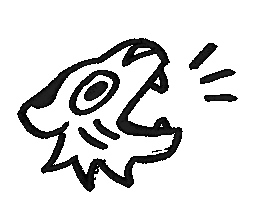DUNCAN GAMAN of Partizan Studio - [Artist Talk]
- Hannah
- Mar 12, 2021
- 4 min read
Updated: May 27, 2021
Duncan Gaman is an executive producer at Partizan Studio in London. He oversees the production of a project, including budget and crew etc., making sure projects are fulfilled to their maximum potential within the timefrane. Recently, we had the pleasure of watching him talk and present the work of Partizan to our course, venturing into what it's like to work in the industry, what goes into a project at Partizan, as well as his own experiences getting to where he is now.
Partizan has two studios—based in London and Paris—that make films and animations, focusing heavily on creating an "experience" and showing fantastic stories and ideas visually. They have been involved in a great variety of impressive projects for a number of well-renowned clients, like Adobe, Vans and Barclays, and create work using a range of mediums and disciplines, from 2D, 3D and stop-motion animation to "immersive technology" and live-action.
During his talk, Duncan showed us a couple of adverts Partizan were involved in and gave us a little bit of behind-the-scenes information.
He discussed a bit about the newest Adobe Creative Cloud advert they had been involved in. As we had just been working on our VFX projects, it was really interesting to have an insight into the advert and see a few of the methods we had learned in class being put to use professionally like this, such as motion tracking, 3D objects and hand-drawn animation combined and used together to make a visually inspiring piece of media. With all of the fantastic visuals and mediums used in this advert, I can certainly see how one would want to use the Creative Cloud for themselves!
Duncan also talked a little bit about the Great Western Railway advert, done using the Famous Five by Enid Blyton. The studio had initially wanted to create the advert using 2D animation to replicate the feel of the books, however, they found that they didn't have enough 2D animators to work on it, so they opted to go with 3D animation instead. By using shaders and painted backgrounds, they were still able to emulate the original style of the books and give the animation its own hand-made feel.
From this, Duncan continued to talk a bit about how they didn't have enough 2D animators initially. He mentioned that they struggled to find quality 2D animators to work on projects for the studio, which prompted a classmate to ask him whether it is then worth focusing more on that area if that's your interest. I found his answer most encouraging; he told us that you should always try and go for the kind/style of animation that you are most interested in and want to focus on, because there isn't really much point focusing on a type of animation that you won't enjoy creating. Furthermore, he said that you can always start out focusing on your preferred type of animation, but then see where that area could take you further into the industry. For example, Duncan himself started out designing characters, but found himself eventually working as a producer.
Also, Duncan said that there has been a boom in 2D animation recently, showing that there is still a lot of interest in that medium, and that there has been a real embracement of craft and working with others from different mediums. He gave us solid pointers for if we want to work in the industry:
Your work is important, but your work ethic, attitude and communication determines whether people will want to have you back.
Try not to always go for perfection, just try your best.
There is (animation) life outside of London, e.g. Bristol, Manchester, Glasgow.
Make a simple, polished, one-page CV.
Get a showreel locked down—punchy, one-minute (with good, high-energy music).
Reach out to artists directly that you might want to work with.
Write to music artists and make your own music video.
Don't be afraid to reach out to email and send applications.
The more influence you can draw from areas, the better your output will be.
It's good to be a multi-faceted creator—have more things going on in your life than just art and animation e.g. other hobbies.
If you're not sure about a particular area of animation you want to focus on/work in, just think about wanting to be in the industry generally and less about a specific area; just see where it takes you.
I found Duncan's talk very reassuring and inspiring. Although I enjoy 2D animation the most, I was worried that it wasn't much of a viable option for me to persue, but hearing a professional within the industry encourage us to go for the areas we like best, it really makes me excited at the possibilities for the future. I know that I personally struggle with time-management, which is something I desperately need to work on if I am to make it within the animation industry, but the talk has given me a new bout of motivation to practice 2D animation more and learn as much as I can to better myself.
Overall, speaking to Duncan was a great, inspiring experience. His words of wisdom and insight into where he first began versus where he is now definitely showed me that anything is possible and if you just continue to learn and create the work that you enjoy making, then there's no telling where you could find yourself in the future!







![JAMES TAYLOR of Arcus Studios - [Artist Talk]](https://static.wixstatic.com/media/e147ae_04714b09182e43739c4ee42fe195b7d5~mv2.png/v1/fill/w_780,h_780,al_c,q_90,enc_avif,quality_auto/e147ae_04714b09182e43739c4ee42fe195b7d5~mv2.png)
![Level 5 Reflection - [University Second Year Overview]](https://static.wixstatic.com/media/e147ae_2a9e8bf67c8b4a1db948e1fd78be0aa8~mv2.jpg/v1/fill/w_980,h_784,al_c,q_85,usm_0.66_1.00_0.01,enc_avif,quality_auto/e147ae_2a9e8bf67c8b4a1db948e1fd78be0aa8~mv2.jpg)
![Digital Storytelling - Module Overview [University]](https://static.wixstatic.com/media/e147ae_c1ac3c036c9c409ea1cea6ee39e92f28~mv2.jpg/v1/fill/w_980,h_598,al_c,q_85,usm_0.66_1.00_0.01,enc_avif,quality_auto/e147ae_c1ac3c036c9c409ea1cea6ee39e92f28~mv2.jpg)
Comments